vatican
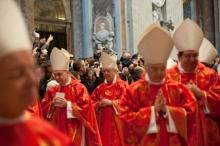
VATICAN CITY — As 115 cardinal-electors solemnly processed into the Sistine Chapel on Tuesday afternoon, with a cry of “Extra omnes!” and the latest high-tech jamming devices cutting them off from the world, the buzz outside the Vatican over who would eventually emerge as pope grew deafening.
Everyone had theories, many had favorites, and most declared it all so unpredictable that the winner – or even how long it would take to find him – was anybody’s guess.
“We are living through an extraordinary conclave,” Marco Tosatti wrote in La Stampa, the Italian daily whose insider coverage of the pre-conclave meetings read like a tip sheet for papal bookies.
“If we look at the history of conclaves over the last century, never has there been such a range of choices, and such uncertainty over the outcome up to the moment that the doors of the Sistine Chapel closed,” he said.
In fact, the latest lines were varied and morphing all the time, a feast of permutations for Vaticanisti who parse papal elections the way sci-fi geeks deconstruct a new installment of “Star Wars.”
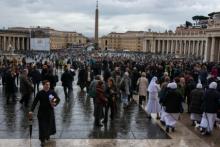
VATICAN CITY — Black smoke from the chimney atop the Sistine Chapel signaled that the first day of the conclave ended without the election of a new pope.
Even if the first-round outcome was largely expected, thousands of people on Tuesday braved the inclement Roman weather to wait for the result of the vote. They slowly filled up St. Peter’s Square as the evening progressed, with their eyes fixed on the small chimney.
Cries of disappointment erupted from the crowd when the black smoke appeared instead of the white smoke that would herald a successful election.
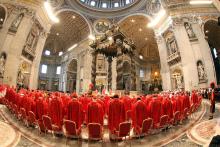
VATICAN CITY — The doors of the Sistine Chapel closed behind the cardinals on Tuesday, marking the official start of the conclave that will elect the successor to Pope Benedict XVI.
The 115 cardinal-electors walked in procession into the Sistine Chapel, singing hymns and invoking the Holy Spirit, before filing under Michelangelo’s “Last Judgment” and taking a solemn oath of secrecy on everything that will happen during the conclave.
At the end of the oath-taking ceremony, the master of papal ceremonies, the Rev. Guido Marini, ordered the “extra omnes” (Latin for “everybody out”).
Cardinals will be sequestered inside a Vatican residence until a candidate receives the two-thirds majority needed for election to the papacy.
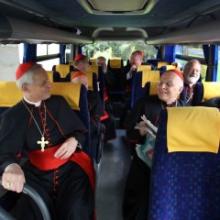
As the Vatican prepares for the opening of the conclave today to elect a new pope, officials announced that the personal secretary of former Pope Benedict XVI will return to Rome for the first time since Benedict’s resignation on Feb. 28.
The Vatican’s chief spokesman, the Rev. Federico Lombardi, confirmed on Monday that Gaenswein will be one of the senior Vatican officials to take part in the solemn procession of cardinals into the Sistine Chapel that will open the conclave on Tuesday afternoon.Archbishop Georg Gaenswein, who was Benedict’s closest aide when he was pope, moved with Benedict to the papal summer residence of Castel Gandolfo when the retired pope left the Vatican on Feb. 28.
His presence will once again highlight the unprecedented situation — and potential complications — of having a retired pope still living just as cardinals gather to elect his successor.
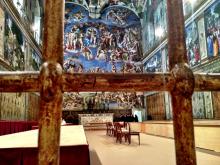
As if the task of choosing the Vicar of Christ and the leader of the world’s 1.2 billion Catholics wasn’t daunting enough, the voting must also take place under the gaze of Michelangelo’s brilliant but imposing frescoes in the Sistine Chapel.
That’s what the late Pope John Paul II decreed when he rewrote the conclave rules in 1996, and so it shall be starting today — and for however many days it takes the 115 cardinal-electors to choose a successor to Pope Emeritus Benedict XVI, who retired last month.
In the Sistine Chapel, “everything is conducive to an awareness of the presence of God, in whose sight each person will one day be judged,” John Paul II wrote in his 1996 Apostolic Constitution “Universi Dominici Gregis,” which regulates papal elections.
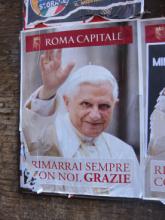
VATICAN CITY — Amid all of the prognosticating about who the cardinals could choose as the next pope in the conclave that starts here on Tuesday, one reliable thread has emerged: the desire to elect a pontiff who can be a pastor to the world as well as a taskmaster to the Roman Curia.
Finding such a combination in a single man, of course, may prove difficult if not impossible, which adds to the almost unprecedented level of uncertainty surrounding this papal election.
So if anything is possible, some say it might be better to reverse the prevailing wisdom — look for a pope who will talk tough to Catholics (and the world) while shepherding the Curia with a firm hand in order to better police the wayward.
The prospect might appall progressives and others who were happy to see the end of Pope Benedict XVI’s papacy, but it has enough appeal to conservatives that they are trying to make the case.
One reason for their sense of urgency is that Cardinal Joseph Ratzinger turned out to be more of a papal pussycat as Benedict XVI than the watchdog of orthodoxy that he had been for decades while serving under John Paul II.
Is now the time for a pope who could be more of a Ratzinger than a Benedict?
VATICAN CITY — The conclave to pick a new pope will begin on Tuesday the Vatican said on Friday, resolving an open question that had dogged the cardinals meeting here over the past week.
The cardinals will celebrate a special Mass “pro eligendo Romano Pontifice” — for the election of the Roman Pontiff — in St. Peter’s Basilica on Tuesday morning, and in the afternoon the cardinals will enter into the Conclave, the Vatican said.
The date was set by the cardinals gathered in a late-afternoon session on Friday. They were scheduled to vote on the decision, but there was no word on how many supported the Tuesday start date or how many preferred an earlier or a later date.
In one of his last acts before resigning on Feb. 28, Pope Benedict XVI amended the law regulating papal elections to allow cardinals to move up the beginning of the conclave, which would normally not be able to start until at least 15 days after a pope dies or leaves office.
Because Benedict resigned — the first pope to do so in 600 years — and announced his plans on Feb. 11, the cardinals did not have to focus on a funeral, as they did when John Paul II died in April 2005. They also have had nearly a month to think about a successor.
As a result, many believed the cardinals did not need to wait long after Benedict’s resignation took effect to begin the conclave itself.
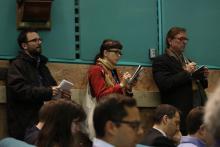
Tensions among the Roman Catholic cardinals meeting here to choose a new pope appeared to escalate on Wednesday as the American prelates in Rome canceled their daily press briefing under pressure from colleagues who are frustrated over news coverage of their secret talks.
The cardinals also announced that they still had not been able to agree on a start date for the conclave, in which 115 electors will cast their ballots for a successor to Pope Benedict XVI.
The effort to control the flow of information from the daily pre-conclave “General Congregation” meetings marked a sharp reversal from the unprecedented openness that had characterized this first papal conclave of the digital age.
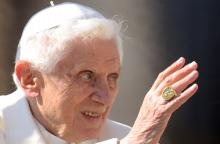
VATICAN CITY — The papacy of Benedict XVI came to a quiet end at 8 p.m. on Thursday, making him the first pope in 600 years to voluntarily leave office.
While there was no formal ceremony to mark the historic passage, the end of Benedict’s papacy and the beginning of the “sede vacante” interim period was clear when the Swiss Guards left their post at the gate of the papal summer residence in Castel Gandolfo.
The Swiss Guards are charged with protecting the pope. When Benedict ceased to be pope, his security was no longer in their hands. At the Vatican, officials sealed the pope’s apartment as prescribed by church law, and will destroy the pope’s ring and official seal in the coming days.

The Vatican appears rocked by scandalous rumors and resignations just as church leaders must gear up to replace frail Pope Benedict XVI with a closed-door conclave.
But Vatican experts say if you think the world’s largest nongovernmental institution is in unprecedented chaos right now, think again.
Vatican Secretary of State Cardinal Angelo Sodano presents the papal fisherman ring to Pope Benedict XVI at the new pope’s installation Mass. The fisherman’s ring bears an image of Peter, his boat and his net, which figure in two Gospel accounts of miraculous catches of fish. Benedict said that while fish die when removed from the sea, “in the mission of a fisher of men the reverse is true.”
“Have you ever heard of the Borgias?” quipped professor Terrence Tilley, chairman of the theology department for Fordham University in New York. They were the larcenous, adulterous, murderous, election-rigging, Renaissance-era family of renaissance popes “who ran the papacy for decades like a private fief.”
For all the sex, money, and power headlines wafting out of Rome these days, at least no one has been murdered. Infighting and innuendo, though, are ancient traditions that have moved into the bright lights of the 24/7 news cycle and social media.
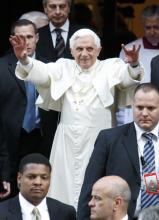
In his final public address, Pope Benedict XVI on Wednesday forcefully defended his decision to resign while trying to reassure Catholics still reeling from the shock of his unprecedented move.
For the first time since his stunning announcement on Feb. 11, the 85-year-old pope explained at length his decision to become the first pope in six centuries to resign. His tenure officially ends Thursday at 8 p.m. local time.
Benedict admitted that his resignation is a “grave” and “novel” act but, he added, his choice had been made “with profound serenity.”
“Loving the church means having the courage to make difficult, agonizing choices, having ever before oneself the good of the church and not one’s own,” he said.
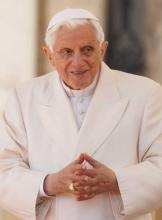
You won’t find many Catholic churches named after Pope Benedict IX.
Benedict IX squandered the papacy’s moral and financial riches in bordellos and banquet halls. His violence and debauchery “shocked even the Romans,” said philosopher Bertrand Russell, which is kind of like being busted for lewdness in Las Vegas. He was a puppet pope, installed by his powerful family at a time when rival clans ruled Rome. The young man seemed uninterested in religious life, rushing through ordination only after his election to the Throne of St. Peter in 1032.
St. Peter Damian called Benedict IX a "demon from hell in the disguise of a priest." The Catholic Encyclopedia labels him a “disgrace to the chair of St. Peter.” He was the first Pope Benedict to resign, selling the papacy for gold in order to marry. He later tried to reclaim the holy office and served three stints as pope between 1032 and 1048.
Nearly a millennium later, the pious and bookish Pope Benedict XVI seems completely contrary to his notorious namesake. Even if his papacy has stumbled at times, by all accounts the current Benedict has led a chaste life devoted to serving his church.
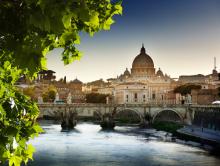
If you want a crash course on how papal politics really works, look no further than the saga of Scottish Cardinal Keith O’Brien.
On Friday, Britain’s most senior Catholic cleric grabbed headlines by telling the BBC that priestly celibacy was “not of divine origin” and that he’d be “happy” if priests had the option to marry.
On Saturday, O’Brien was back in the news, this time after four men reportedly accused him of “inappropriate acts” dating back to the 1980s.
By Monday, O’Brien had resigned as archbishop of Saint Andrews and Edinburgh and announced he would skip the conclave.
From champion of married priests to disgraced churchman within 72 hours, O’Brien’s trajectory is stunning but also emblematic of the frenetic and fever-pitched campaigning that occurs during the tiny window between a pope’s death or resignation and the election of his successor.
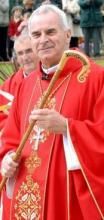
Cardinal Keith O’Brien of Scotland resigned on Monday in the wake of explosive charges that he had made “inappropriate” sexual advances to four men, three of them priests, and one now a former seminarian, starting in the 1980s.
O’Brien said he would skip next month’s conclave to elect a successor to Pope Benedict XVI, leaving the United Kingdom without a cardinal’s voice in the election of a new pope.
In a statement, O’Brien said Benedict had accepted his resignation effective immediately, and he appeared to allude to the events surrounding his sudden exit.
“Looking back over my years of ministry: For any good I have been able to do, I thank God. For any failures, I apologize to all whom I have offended,” said the cardinal, who turns 75 next month, which is the mandatory retirement age for bishops. Cardinals retain the right to vote in a conclave until age 80.
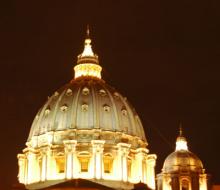
VATICAN CITY — As of 8 p.m. on Feb. 28, Pope Benedict XVI will no longer be pope and the Vatican will go into “sede vacante” mode — a Latin expression that means that the seat of St. Peter is vacant.
So who’s in charge until a new pope is chosen? The “interregnum” between two popes is governed by ancient rituals and by institutions half forgotten even within the Vatican.
But it is also the only time that the Catholic Church comes close to vaguely resembling a democracy, with the College of Cardinals acting somewhat like a Parliament with limited powers as it prepares to choose the new pontiff in a closed-doors conclave.

As the 117 Roman Catholic cardinals walk into the Sistine Chapel next month for the election of a new pope, one hopes that they fully recognize the unfolding, dramatic pilgrimage of world Christianity: The demographic center of Christian faith has moved decisively to the Global South.
Over the past century, this astonishing demographic shift is the most dramatic geographical change that has happened in 2,000 years of Christian history. Trends in the Catholic Church — comprising about 1 out of 2 Christians in the world — have generally followed this global pattern:
- In 1900, about 2 million of the world’s Catholic faithful lived in Africa; by 2010, this had grown to 177 million.
- 11 million Catholics were found in Asia in 1900; by 2010 there were 137 million Asian Catholics.
- Through colonial expansion, 59 million Catholics populated Latin America and the Caribbean in 1900; but by 2010, that number had grown to 483 million.
- In 1900, two-thirds of the world’s Catholic believers were in Europe and North America; today, two-thirds are in Latin America, Africa, and Asia.
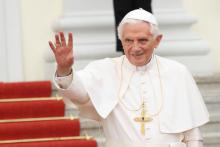
VATICAN CITY — Pope Benedict XVI will soon become the first pope to resign since 1415, short-circuiting many of the initial stages of electing a new pope. But the Vatican says the transition to a new papacy shouldn’t be all that different from normal.
Of course, the traditional rituals associated with confirming the death of a pope and planning his funeral will not be necessary. But the process outlined below, rife with secrecy and tradition, will largely follow centuries-old protocol.
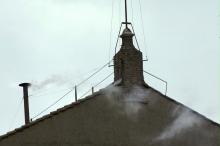
Following is a brief explanation of the process used in a conclave to elect a new pope.
Q: Who governs the church until a new pope is elected?
A: Day-to-day operations are handled by the Vatican curia, the central bureaucracy. All prelates who head Vatican agencies resign after the death or resignation of a pope. Provisions are made to oversee the papal household, the spiritual needs of Romans and to grant absolutions.
Q: What does the word “conclave” mean?
A: The word comes from the Latin, “with a key,” referring to the tradition of locking the doors until cardinals elect a winner.
Q: Who is eligible to be elected pope?
A: Technically, any baptized male Catholic is eligible, provided he is not married and in good standing with the church. Since 1378, however, new popes have come from within the College of Cardinals.
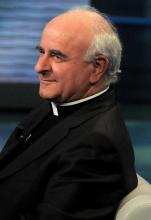
VATICAN CITY — A top Vatican official blamed the media for “derailing” his recent remarks on possible legal protections for unmarried couples, while reaffirming his support for British and French bishops who have been vocal opponents of same-sex marriage.
Speaking at a Vatican press conference on Monday, Archbishop Vincenzo Paglia, head of the Pontifical Council for the Family, had acknowledged that nations could find “private law solutions” to protect the rights of unmarried couples — including, potentially, gay and lesbian couples.
Paglia also said the church should support the repeal of laws that criminalize homosexuality in various countries.
His remarks were widely repeated, with some interpreting it as a softening of the Vatican’s stance just as bishops in France and Britain are furiously opposing the legalization of same-sex marriage.
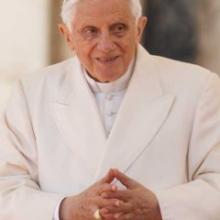
VATICAN CITY — Pope Benedict XVI has asked the Vatican’s highest appeals court to consider reviewing church rules on marriage annulments — a statement that may signal a change in tone more than a change in substance.
Speaking on Jan. 26 to the members of the tribunal of the Roman Rota, Benedict said that “lack of faith” on the part of the spouses can affect the validity of a marriage.
While the Catholic Church forbids remarried divorcees from taking Communion, church tribunals can declare a marriage void if it can be demonstrated that some key elements — such as a commitment to have children — were missing in the first place.